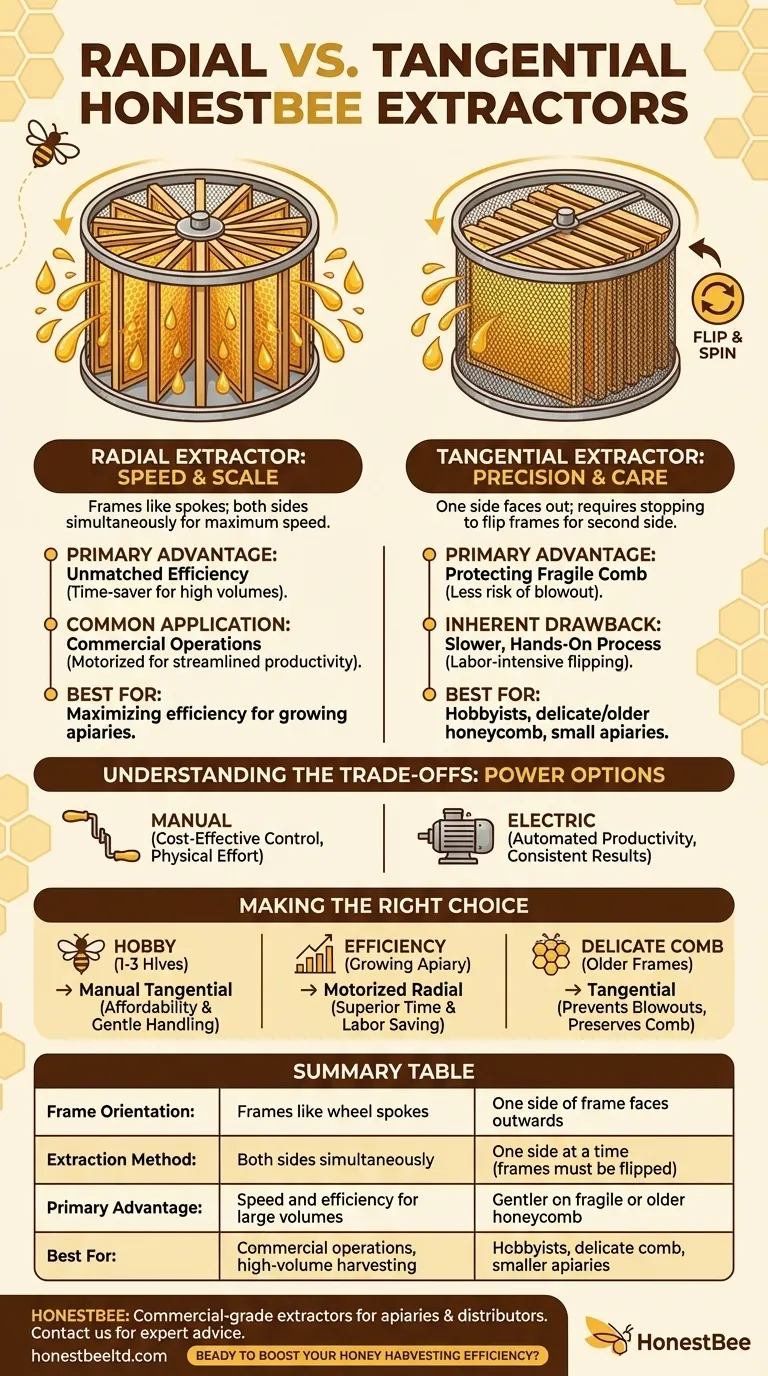The fundamental difference between a radial and a tangential honey extractor lies in the orientation of the frames and the method of extraction. A radial extractor positions frames like the spokes of a wheel, extracting honey from both sides simultaneously for maximum speed. A tangential extractor places one side of the frame facing outwards, requiring you to stop and flip the frames to extract honey from the second side.
Your choice between these two designs represents a core trade-off. Radial extractors are built to prioritize speed and efficiency, making them ideal for larger operations, while tangential extractors are designed to be gentler on the comb, suiting hobbyists or those with fragile honeycomb.

The Radial Extractor: Built for Speed and Scale
A radial extractor is the workhorse of honey harvesting, designed to process a large number of frames with minimal manual intervention.
How It Works: The "Spokes of a Wheel"
In a radial extractor, frames are placed on end with their bottom bars facing the center of the basket. As the machine spins, centrifugal force pulls the honey out from both sides of the comb at the same time.
Primary Advantage: Unmatched Efficiency
The ability to extract honey from both sides at once is a significant time-saver. This eliminates the need to stop the machine, open the lid, and manually turn each frame, which is the main bottleneck in a tangential system.
Common Application: Commercial Operations
Because of their speed and higher capacity (ranging from 6 to over 20 frames), radial extractors are the standard choice for commercial beekeepers. They are most often motorized to further streamline the process and increase productivity.
The Tangential Extractor: Designed for Precision and Care
A tangential extractor operates on a different principle, focusing more on protecting the integrity of the honeycomb than on raw speed.
How It Works: The "One-Sided" Approach
Frames are placed in the basket with one side resting against the outer mesh wall. When the extractor spins, honey is flung from only the outward-facing side of the comb.
Primary Advantage: Protecting Fragile Comb
This method is significantly gentler on the honeycomb. Because the comb is fully supported by the mesh screen, there is less risk of it breaking or "blowing out" during extraction, making it ideal for older, more delicate combs.
Inherent Drawback: A Slower, Hands-On Process
The main disadvantage is the labor-intensive process. You must extract one side, stop the machine, flip every frame, and then spin again to extract the other side. This makes the overall process take considerably more time and effort.
Understanding the Trade-offs: Manual vs. Electric Power
Beyond the core design, you must also decide between a manual or electric motor, a choice that applies to both radial and tangential models.
The Manual Option: Cost-Effective Control
Manual, hand-crank extractors are more budget-friendly and give you direct control over the extraction speed. They are an excellent starting point for hobbyists with only a few hives, but they require significant physical effort.
The Electric Option: Automated Productivity
Electric extractors are more expensive but dramatically reduce labor and speed up the process. They offer more consistent results and are the clear choice for any beekeeper looking to increase production and minimize time spent in the honey house.
Making the Right Choice for Your Apiary
Your decision should be based entirely on the scale of your operation and your primary goal.
- If your primary focus is a small hobby with 1-3 hives: A manual tangential extractor offers the best balance of affordability and gentle handling for your comb.
- If your primary focus is maximizing efficiency for a growing apiary: A motorized radial extractor is the superior investment, saving you significant time and labor.
- If your primary focus is processing older or delicate comb: A tangential extractor provides the necessary support to prevent blowouts, preserving your valuable drawn comb.
Ultimately, choosing the right extractor is about aligning the tool's core strengths with the specific needs of your beekeeping journey.
Summary Table:
| Feature | Radial Extractor | Tangential Extractor |
|---|---|---|
| Frame Orientation | Frames like wheel spokes | One side of frame faces outwards |
| Extraction Method | Both sides simultaneously | One side at a time (frames must be flipped) |
| Primary Advantage | Speed and efficiency for large volumes | Gentler on fragile or older honeycomb |
| Best For | Commercial operations, high-volume harvesting | Hobbyists, delicate comb, smaller apiaries |
Ready to Boost Your Honey Harvesting Efficiency?
Choosing the right extractor is crucial for your apiary's productivity. HONESTBEE supplies commercial-grade radial and tangential honey extractors to commercial apiaries and beekeeping equipment distributors.
We understand the unique demands of high-volume operations. Our wholesale-focused approach ensures you get the durable, efficient equipment you need to maximize your yield.
Let's discuss the best solution for your honey house. Contact our team today to get expert advice and pricing on extractors that match your scale and goals.
Visual Guide

Related Products
- HONESTBEE 3-Frame Manual Acrylic Honey Extractor
- 24 Frame Honey Extractor Commercial Radial Honey Frame Extraction Machine
- electric honey extractor honey centrifuge 3 frame honey extractor stainless steel honey frame extractor
- Stainless Steel 3 Frame Manual Honey Extractor Spinner for Bee Honey Extraction
- 2 Frame Stainless Steel Manual Honey Spinner Extractor for Beekeeping
People Also Ask
- How often do beekeepers collect honey? Maximize Your Hive's Sustainable Yield
- Which type of honey extractor is generally more durable? Focus on Material & Build Quality for Longevity
- How do you collect honey at home? A Beginner's Guide to Harvesting from Your Hive
- What size honey extractor do I need? Match Frame Capacity to Your Hives for Maximum Efficiency
- How to extract honey by hand? A Guide to Crush & Strain vs. Manual Extractors



















